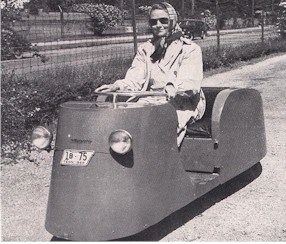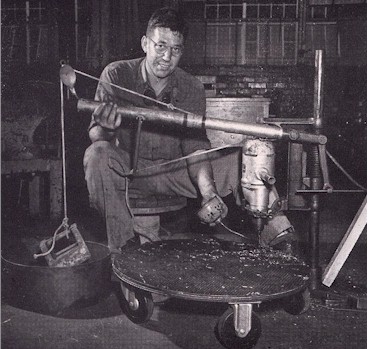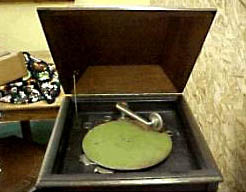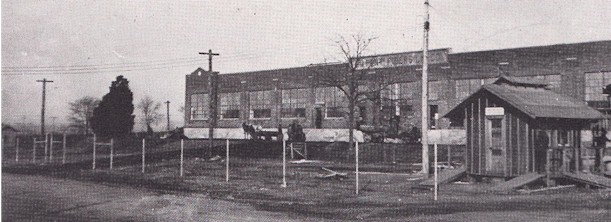Thinking
Behind the Other Fellow
Robert L. Lewis, jr. - Rayon Yarns,
March 1941
|
When Edison discovered that words and music could be recorded on a
little round cylinder and then replayed on a device called the
graphaphone, everyone thought of it as being perfect.
But look at the bright and colorful nickelodeon of today with the
automatic record changer and remote control. This was accomplished
because a few men thinking behind Edison, and using his machine for a
start, developed the automatic record changer, added the nickel device,
adopted the already present method of remote control, and lighted their
machine finally with du Pont plastics.
This is only one example of thousands, the modern telephone,
telegraph, cotton gin, streamlined autos, locomotives, and ocean liners,
airplanes, sewing machines, steam engines and radio and television were
once crude, awkward machines. But look at them today, more useful, more
efficient, and more beautiful, all because a few men ‘thinking behind’
Bell, Morse, Whitney, the Wrights, Fulton, Howe, Watts, Marconi, and
others added their improvements to the other’s inventions. Now these
are owned by or are at the disposal of nearly everyone.
The same things have happened in our plants. Machines and processes
have been developed and improved and we are producing the best product
of its kind.
We can’t all be like the men who invented these machines, but if we
keep thinking behind these men we may be able to improve on them.
And last but not least, great sums of money are paid out every year
for the man who ‘thinks behind the other fellow.’
|
|
|

|
| This is Edna Felder, DuPont registered nurse, in
1948. Working shifts, she had a choice of hitch-hiking to
the bus line, walking down a couple of miles of dark road, or
paying a round trip cab fare of $1.50 every time she came to
work. She solved the problem by purchasing a
Motorette, a two-passenger gasoline "scooter".
The Motorette cost about $300 in 1948 and got up to 50-60 miles
per gallon with maximum speeds of 45 miles per hour. This
odd contraption was a one-cylinder, air cooled, four-horsepower
motor and operated on a chain drive with an automatic
shift. There was no reverse, but turned around in the
space on which it sat.
The Easier Way
Rayon Yarns - September 1949 |
|
 |
| Charles Haney |
|
| Not long ago millwright
Charles Haney had a job of drilling 4500 holes in each of four
boiler plates which together weighed about 150 pounds.
That's 18,000 holes and by the time Haney had moved the bench
drill up and down a few times by hand power he decided there
must be a better way of doing the work.
He gave the matter a little thought and
came up with a Rube Goldberg idea that turned the muscle-binding
job before him into a pleasant pastime no more strenuous than
manipulating a casting rod beside some sparkling stream.
Note: Rube Goldberg
was a Pulitzer-Prize winning cartoonist. Through his
'INVENTIONS' cartoons, Rube Goldberg showed difficult ways to
achieve easy results. His cartoons were, (as he said), symbols
of man's capacity for exerting maximum effort to accomplish
minimal results. Rube believed that there were two ways to
do things: the simple way and the hard way, and that a
surprisingly number of people preferred doing things the hard
way. Source: http://www.rube-goldberg.com/
Bolting the four plates together, Haney
fastened three wheels under them and set them on the
floor. He rigged the bench drill over them and fastened to
it a length of pipe, two pulleys, a rope and a counter weight as
shown in the picture.
By tugging gently on the end of the
rope (see coil near Haney's right knee) he was able to make the
drill feed automatically and with one hand he effortlessly moved
the plates into the next position after each hole was drilled.
Of course there were those who made the
usual cracks about working to get out of work and great
inventions being made by lazy men. But the real moving
power behind this stroke of genius came to light later.
It seems that the city golf tournament
was due to open in two weeks and Haney didn't aim to have a sore
shoulder when he teed off for the first round.
|
|
|
|
|
|
|

|
| Note: The
graphaphone was the predecessor to the gramaphone, and is often
confused with it. The difference is that the graphaphone used
wax tablets to record the music on, and was of poorer sound
quality. The wax tablets were often in the shape of a cylinder,
and later in a platter shape (as shown above). In actuality,
Edison invented the phonograph. The graphaphone was an
invention that took the concept of the phonograph and made it
far superior. |
|
|
|
|
|
|
|
|
|
|
|
|
|
|
|
|
|
|
|
|
|
|
|
|
|
|
|
|
|
|
|
|
|
|
|
|
|
|
|
|
|
|
|
|
|
|
|
|
|
|
|
|
|
|
|
|
|
|
|
|
|
|
|
|
|





